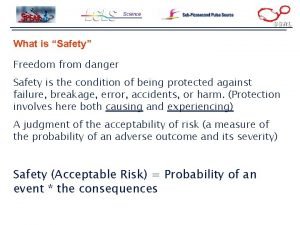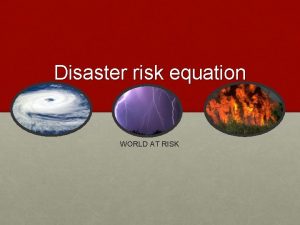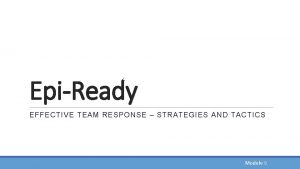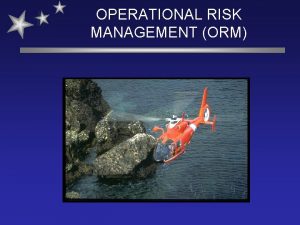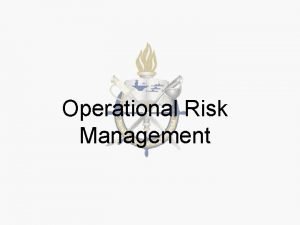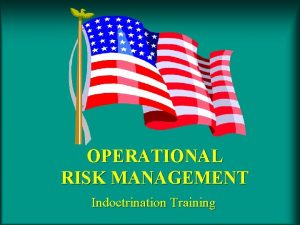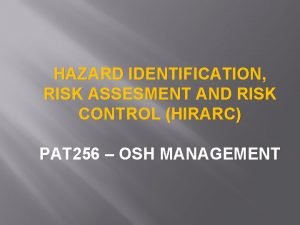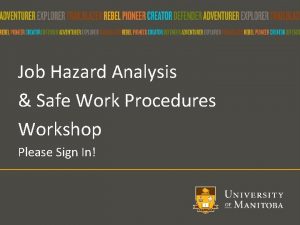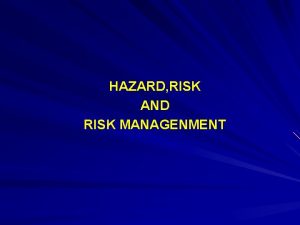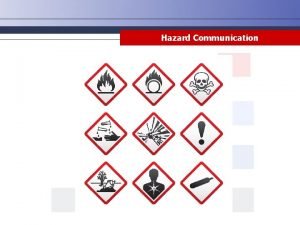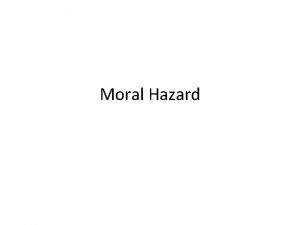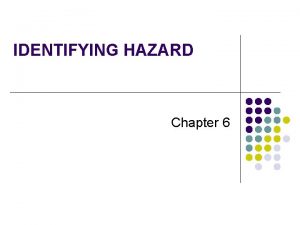Hazard Threats Risk Etc An examination of some

















- Slides: 17

Hazard, Threats, Risk, Etc. An examination of some key terms … Walter G. Green III, Ph. D. , CEM Disaster Theory Series No. 3 Copyright 2008 by Walter G. Green III - use by researchers or in University course work is permitted.

HAZARDS o Existing condition or possible (under current conditions) situation that has the potential to generate a disaster o Natural hazards – naturally occurring phenomena – weather, topographic, geological, hydrological, etc. o Human systems developed – caused by human activity, infrastructure, transportation, etc. o Conflict based – civil war, terrorism, nuclear war, etc.

HAZARDS o Hurricanes and tornadoes during their seasons o Earthquakes o High hazard, poorly maintained dams o Airlines with abysmal safety records o Power production systems with either dangerous technologies or poorly maintained transmission systems

VULNERABILITIES o If you have a hazard you may or may not be vulnerable to it n Live in the flood plain – vulnerable to floods n Live on high ground – not vulnerable to floods o Vulnerability is an assessment of how well or how poorly protected you are against an event

VULNERABILITIES o Vulnerabilities may be reduced by mitigation measures (building construction, land use control, maintenance, etc. ) o Or by the level of preparedness you have achieved (well trained and equipped emergency teams, plans, exercises, etc. )

RELATED TO VULNERABILITY o Three factors may influence the determination of vulnerability n Criticality – how important is the asset or function that is subject to impact n Exposure – to how much of the force of the event is the resource exposed n Time – does vulnerability fluctuate over time of day, month, season?

IMPACT o Assessment of interaction of hazard effects with your vulnerabilities o Scalar based on the two key variables – hazard strength and vulnerability level o Will be hazard specific in aggregate (hurricane impacts), but may be functionally common to a variety of hazards in the specific (power loss)

IMPACT MODERATE Strong Hazard Low Vulnerability HIGH Strong Hazard High Vulnerability LOW Weak Hazard Low Vulnerability MODERATE Weak Hazard High Vulnerability

RELATED TO IMPACT o Two other factors are related to impact n Magnitude – the absolute size and power of the event n Intensity – the measurement of the effects of the event – how it is felt o All else being equal an event with greater magnitude will tend to be a more intense event and generate greater impacts

CONSEQUENCES o Result of the interaction of the Impact of the event with other systems n Political, n Social and cultural, n Economic, etc. o May set the stage for either: n Future events, or n Vulnerability reduction through mitigation and preparedness

CONSEQUENCES o The border between consequence and impact is fuzzy, but n Impacts tend to be directly related to the effects of the event, consequences more second order n Impacts tend to be shorter term (hours to decades), consequences longer term (weeks to centuries) n Although coupled to impacts, consequences are neither automatic nor irreversible n Consequences tend to be more human-centric, impacts more event-centric – we make the consequences, the event makes the impact

PROBABILITY o A mathematical assessment of how likely it is that a specific event will occur o Based on a wide variety of factors – history, global warming, infrastructure and demographic changes, new industries, changes in your activities and processes, etc.

PROBABILITY o Expressed in a variety of ways: n This year we expect 14 named tropical storms, 8 hurricanes, 3 great hurricanes … (an assessment of general level) n There is a 45% chance of … (a numerical assessment) n A 500 year flood … (a statement of cycles) n And then there is likelihood: “I think it is highly likely that …” (a qualitative assessment)

LIKELIHOOD o An inexact, qualitative statement of how one assesses probability o Generally expressed in broad bands that cover a range of probability values n High – “likely” n Low – “unlikely” o Easily understood, but also misleading – likely is interpreted as “yes, it will, ” unlikely as “no, it will not”

THREAT o The operationalization of vulnerability, expected impact of a developing hazard, and the probability that impact will work against your vulnerabilities o Threat means something bad is coming your way – high threat means it is highly likely to hit you and it will be very bad

RISK o Expressed in a wide variety of ways based on what you are using risk for – financial risk, operational risk, etc. o Classic risk model in disaster response is: Risk = Probability x Impact

THE FLOW HAZARD VULNERABILITY THREAT IMPACT ^ ^ CONSEQUENCE PROBABILITY RISK
 Liquidity measures
Liquidity measures Freedom from danger
Freedom from danger Equation for disaster risk
Equation for disaster risk Sandman risk hazard outrage
Sandman risk hazard outrage Deliberate orm
Deliberate orm Tcrm orm
Tcrm orm Time critical risk management
Time critical risk management Difference of hazard and risk
Difference of hazard and risk Hirarc contoh
Hirarc contoh Example of hazard
Example of hazard Ice cream is uncountable or countable
Ice cream is uncountable or countable Contact force
Contact force They say sometimes you win some
They say sometimes you win some Some say the world will end in fire some say in ice
Some say the world will end in fire some say in ice Fire and ice diamante poem
Fire and ice diamante poem Sometimes you win some
Sometimes you win some Some trust in chariots and some in horses song
Some trust in chariots and some in horses song Medium risk examples
Medium risk examples

